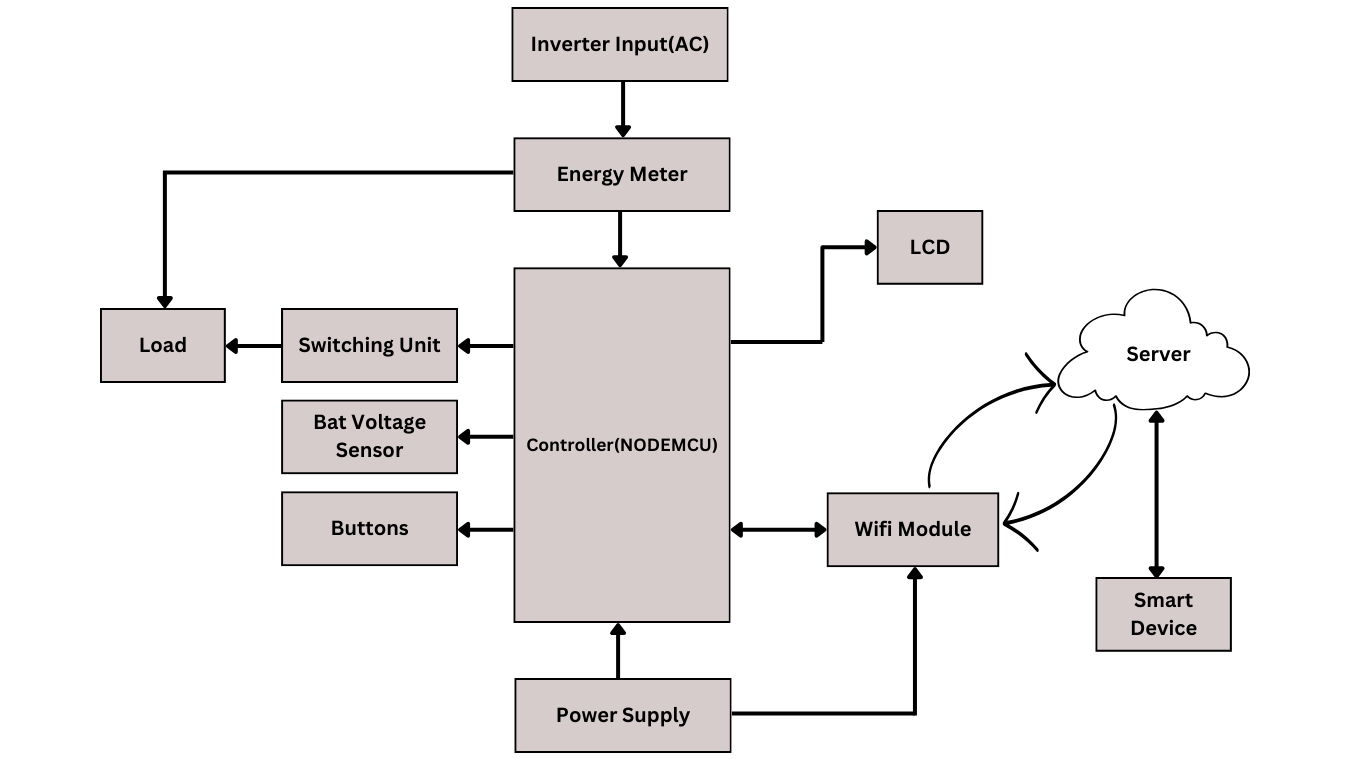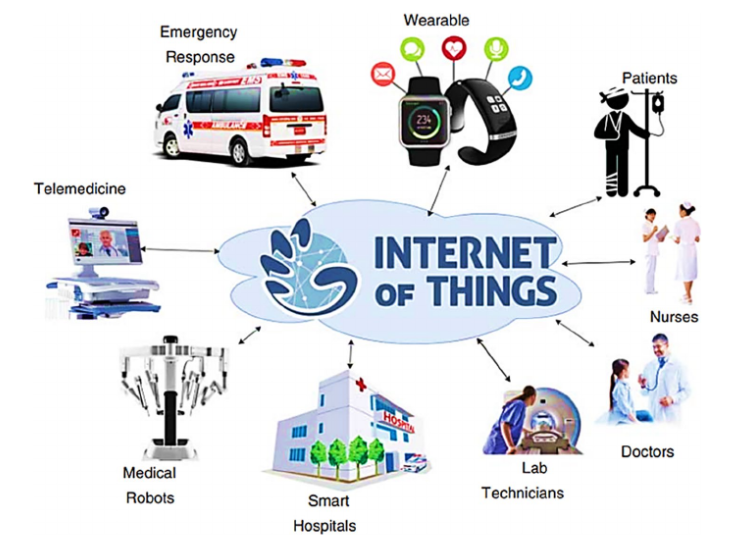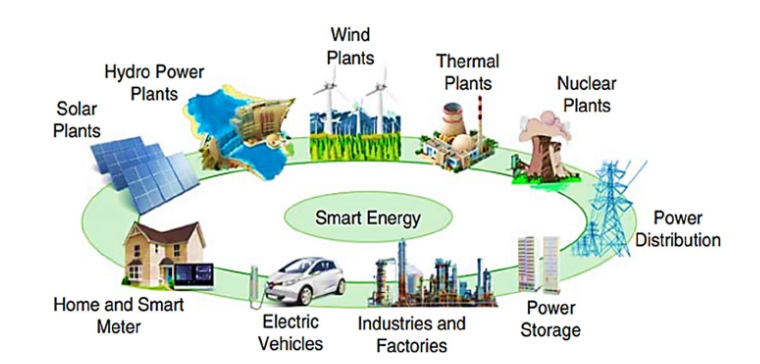The convergence of two transformative technologies, solar energy and the Internet of Things (IoT), is shaping the future of smart cities, industries, and households. Solar-powered IoT combines solar energy harvesting with connected devices, enabling seamless, energy-efficient, and sustainable operations across various applications. From smart cities to agriculture, healthcare to logistics, deploying solar-powered systems creates a cleaner, more connected world. This article explores in detail the concept, applications, and benefits of solar-powered Internet of Things, and its role in addressing the global challenges of energy consumption and climate change.
Table of Contents
What is Solar-Powered IoT?
The Internet of Things (IoT) connects physical devices that gather and share data, such as sensors in smart cities or homes. Internet of Things can enhance renewable energy, like solar photovoltaic (PV) systems, by enabling smarter energy management. Solar inverters, crucial for converting sunlight into electricity, can be controlled remotely via IoT. This remote monitoring prevents overloading, overheating, and potential failures, increasing the inverter’s lifespan. By using IoT to monitor and control inverters, energy efficiency improves, ensuring more reliable and sustainable solar power generation.
How Solar-Powered IoT Works
Solar-powered Internet of Things is a blend of solar energy harvesting technology and the Internet of Things (IoT), creating systems that can autonomously operate using clean, renewable energy. These systems allow devices to function without relying on traditional electricity grids, making them ideal for remote locations, outdoor applications, and sustainable energy solutions. Here’s how the technology works in detail:
1. Solar Panels and Energy Harvesting
Typically, solar power is meant when discussing energy harvesting for Internet of Things devices. Right now, it’s the most widely used method of energy harvesting. It’s not the only one, though. A few other power sources that might be used in the future to maintain our Internet of Things deployments are as follows:
Kinetic energy harvesting (such as a button that senses when someone pushes it) Harvesting thermal energy (such as with a water meter that collects heat energy from a hot water pipe) Radiofrequency (RF) energy harvesting (a wearable for consumers that uses ambient RF waves to wirelessly generate power). These technologies are all evolving quickly. However, for the time being, solar panels are almost always included when IoT industry insiders refer to “energy harvesting.”
2. Energy Storage and Battery Integration
One of the key components of a solar-powered Internet of Things system is energy storage. Since solar energy is not available continuously (e.g., at night or on cloudy days), energy storage solutions such as batteries are essential. Excess energy generated during the day is stored in batteries, ensuring that IoT devices can continue functioning when sunlight is not available.
3. IoT Devices and Sensors
IoT devices in solar-powered systems consist of a wide range of sensors and actuators that perform specific tasks based on data collected from their environment. These devices gather information such as temperature, humidity, light levels, and motion, which is then transmitted to a central system for analysis.
- Low-Power Sensors: Many Internet of Things devices used in solar-powered systems are designed to be energy-efficient, consuming minimal power to extend battery life and make the most of limited solar energy. These sensors often operate in sleep mode when not actively gathering data, further conserving energy.
- Actuators: In addition to sensors, solar-powered Internet of Things systems may include actuators that perform actions such as turning lights on or off, opening valves, or adjusting settings in response to sensor input.
4. Data Transmission and Communication
Communication modules in Internet of Things systems enable the transmission of data from sensors to central processing units or cloud-based systems. To optimize power savings in an Internet of Things system fueled by solar energy, communication protocols are selected depending on their energy efficiency. Low-Power Wide-Area Networks (LPWANs) are Sigfox and LoRaWAN are two popular technologies used in solar-powered Internet of Things devices. These protocols are perfect for remote monitoring applications since they provide long-range communication with low energy usage.
Wi-Fi and Bluetooth Low Energy (BLE) are Energy-efficient Wi-Fi and Bluetooth Low Energy (BLE) protocols that are used to transfer data between devices and hubs in shorter-range applications. These protocols lengthen the battery life of Internet of Things devices by lowering the power required for wireless communication. Mesh Networks are Internet of Thingsdevices that can work together to create mesh networks in which each device serves as a node with the ability to send data to other nodes. As a result, fewer powerful central hubs are required, which uses less energy.
5. Edge Computing and Cloud Integration
Data collected by Internet of Things sensors can either be processed locally using edge computing or transmitted to the cloud for analysis. In solar-powered Internet of Things systems, edge computing is often preferred to reduce the amount of energy required to send data over long distances.
- Edge Computing: With edge computing, data is processed near its source (on the Internet of Things device itself or in a nearby gateway). This reduces latency and the need for constant communication with the cloud, which can drain energy resources.
- Cloud Computing: In cases where complex data analysis is required, solar-powered IoT systems can still transmit data to cloud-based systems. However, energy-efficient transmission protocols and scheduling techniques are employed to conserve power, sending data only when necessary.
6. Power Management Systems
Power management plays a critical role in ensuring that solar-powered Internet of Things devices operate optimally. These systems regulate the flow of energy from the solar panel to the battery and IoT devices, ensuring that power is distributed efficiently.
- Power Regulation Circuits: These circuits manage the distribution of power between the solar panels, energy storage, and Internet of Things devices. They help prevent overcharging or over-discharging batteries and ensure stable power supply even during periods of low sunlight.
- Energy Harvesting Modules: Specialized modules optimize the collection of solar energy, adjusting the angle of solar panels or switching between multiple energy sources (e.g., solar and wind) to maximize energy capture.
7. Maintenance and Monitoring
A solar-powered Internet of Things system’s operational status can be monitored remotely, reducing the need for on-site maintenance. IoT sensors can track battery health, solar panel performance, and energy consumption, sending alerts when maintenance is required or when energy levels drop too low.
- Self-Monitoring Systems: Some advanced Internet of Things devices can monitor their own performance and optimize energy use by adjusting their operation based on available solar power. For example, an IoT system may reduce data transmission frequency during cloudy days to conserve energy.

Applications of Solar-Powered IoT
Solar-powered Internet of Things systems are versatile and scalable, finding applications in various sectors:
1. Smart Cities
Internet of Things transforms existing technology into smarter systems, and when integrated with green technology, such as solar energy, it can greatly enhance efficiency. Energy losses and global warming are major concerns, and IoT integration can help mitigate them by improving solar panel performance. In smart cities, IoT sensors like LDR and motion sensors control street lighting systems to reduce power loss, while a Master Control Unit (MCU) manages the process. IoT can track solar panel conditions, optimize energy output, and store data on cloud platforms for real-time monitoring.
Agrivoltaic systems, combining solar panels with farming, benefit from IoT, while solar tracking systems using MPPT (Maximum Power Point Tracking) technology improve energy capture by aligning panels with the sun. Internet of Things enhances fault detection in solar panels, providing real-time data through apps like Blynk. This technology also has agricultural applications, such as AAFAMS (Automated Agricultural Field Analysis and Monitoring System), which automates field monitoring, pest detection, and soil testing, increasing farming efficiency.
In healthcare, solar-powered Internet of Things systems are revolutionizing the industry by supporting smart healthcare solutions. The combination of solar energy and IoT is highly beneficial for a variety of sectors, helping to reduce energy losses and improve sustainability.

2. Agriculture
In agriculture, IoT sensors track soil moisture, temperature, and nutrients to enhance precision farming, boosting crop yields while conserving resources like water and energy. In agriculture, solar-powered IoT systems enable precision farming by monitoring soil conditions, weather patterns, and crop health. Solar-powered sensors are deployed in fields to measure moisture levels, temperature, and nutrient content. This data is transmitted to farmers in real-time, enabling them to make informed decisions about irrigation, fertilization, and pest control. Solar-powered drones are also used to survey crops and monitor livestock.
In conclusion, solar-powered agriculture combined with IoT technology can enhance farming efficiency, productivity, and sustainability. By using solar energy, farmers reduce fossil fuel reliance, cut energy costs, and lower carbon emissions. IoT devices like sensors and drones enable real-time monitoring of crop health, soil moisture, and weather, promoting precision farming and resource optimization.
This integration addresses challenges like climate change, water scarcity, and food security, boosting crop yields and sustainability. However, high costs, training needs, and data privacy concerns must be addressed. Overall, it holds great promise for the future of farming, warranting further research and investment.
3. Environmental Monitoring
IoT-based environmental monitoring has gained popularity across various industries due to its ability to improve efficiency and sustainability. In manufacturing, the Internet of Things helps monitor emissions, air quality, and wastewater, ensuring compliance with regulations and reducing pollution, while also improving energy efficiency. In the energy sector, the Internet of Things is used in renewable setups like solar and wind farms to optimize energy production and maintenance.
It also supports smart grids for better energy management. In environmental conservation, Internet of Things tools like drones and sensors monitor wildlife and ecosystem changes, aiding in effective habitat protection and management.
4. Logistics and Supply Chain
The Internet of Things plays a crucial role in various stages of supply chain management:
1. Real-time Tracking: Internet of Things devices attached to goods and containers transmit location data, allowing managers to monitor shipments and take action if there are delays or unauthorized stops.
2. Monitoring Storage Conditions: Internet of Things helps maintain optimal environmental conditions (e.g., temperature, humidity) in shipments and warehouses, reducing spoilage of perishable items.
3. Arrival Time Estimation: Internet of Things improves estimates of goods’ arrival by tracking movement speed and traffic conditions, helping avoid delays.
4. Contingency Planning: Analyzing the data from past shipments allows managers to create flexible plans and reroute shipments in real time to avoid risks.
5. Locating Goods in Storage: Internet of Things, combined with RFID and AI, helps track and locate goods in large warehouses, automating operations and boosting efficiency.
6. Administrative Automation: Internet of Things real-time tracking triggers tasks like onward shipping requests, inspections, and payments upon goods’ arrival.

5. Healthcare
Advances in IoT and wireless sensor networks have enabled remote monitoring of physiological indicators like heart rate, oxygen saturation, temperature, and blood pressure, crucial for diagnosing diseases. These technologies allow patient data to be transmitted remotely, helping doctors make timely decisions without hospital visits. Recent systems like MobiHealth and MobiCare use mobile networks to transmit vital signs, while other innovations utilize microcontrollers, Raspberry Pi, and cloud computing for real-time health data monitoring. Despite earlier inefficiencies, new solutions offer faster, solar-powered data transmission, enabling doctors to monitor patients via web servers, improving efficiency, and maintaining data security.
6. Energy Management
The global climate crisis has driven the need for sustainable energy solutions in buildings, which are major contributors to greenhouse gas emissions. Smart buildings, powered by IoT, offer real-time monitoring, control, and optimization of energy consumption, improving energy management. Key advancements include real-time energy tracking, occupancy-based optimization, intelligent lighting and HVAC systems, and demand response strategies. IoT also enhances solar energy systems by enabling better performance tracking and integration with smart grids.
An integrated energy management system, combining heat pumps, photovoltaics, solar thermal panels, and a low-enthalpy radiant system, leverages IoT and cloud-based control for real-time data monitoring and optimization. Using Modbus, HTTP, and MQTT protocols, this system has been successfully implemented in homes in Paris and Spain, demonstrating self-sufficiency, improved thermal comfort, and energy efficiency. This solution highlights the potential of IoT-enabled solar-powered smart buildings in reducing the environmental impact of the building sector.

Advantages of Solar-Powered IoT
Solar-powered Internet of Things (IoT) systems offer a multitude of advantages that enhance their functionality, sustainability, and cost-effectiveness. By harnessing solar energy, these systems operate autonomously and contribute to a greener future. Here are some of the key advantages of solar-powered IoT:
1. Sustainability and Environmental Impact
One of the most significant advantages of solar-powered IoT systems is their reliance on renewable energy. Solar power is abundant, sustainable, and has a minimal environmental footprint compared to fossil fuels.
- Reduction in Carbon Emissions: By utilizing solar energy, these systems help reduce greenhouse gas emissions, contributing to the fight against climate change.
- Promoting Renewable Energy: Solar-powered IoT systems support the transition to renewable energy sources, fostering a more sustainable energy landscape.
2. Energy Independence
Solar-powered IoT devices are not reliant on the electrical grid, making them ideal for remote or off-grid locations.
- Remote Operation: These systems can function in areas without access to traditional power infrastructure, such as rural farms, disaster-stricken regions, or wildlife monitoring sites.
- Reduced Utility Costs: By generating their own electricity, solar-powered IoT devices can significantly lower operational costs related to energy consumption.
3. Enhanced Reliability
Solar-powered IoT systems are designed to operate continuously, even in challenging conditions.
- Resilience Against Power Outages: With their energy storage systems, these devices can maintain functionality during grid failures or outages.
- Consistent Performance: By leveraging solar energy, these systems can maintain consistent operational performance, which is essential for critical applications like monitoring and control systems.
4. Scalability
Solar-powered IoT systems can be easily scaled up or down, depending on the requirements of the application.
- Flexible Deployment: Organizations can add more solar panels or IoT devices without extensive infrastructure investments, allowing for incremental growth as needed.
- Cost-Effective Expansion: As energy needs grow, additional solar panels and IoT devices can be integrated seamlessly into existing systems.
5. Low Maintenance Costs
Solar-powered IoT systems typically have lower maintenance requirements compared to traditional power systems.
- Durability: Solar panels and battery systems are designed to last for several years with minimal upkeep, reducing long-term operational costs.
- Self-Sustaining: With their self-powered nature, these devices require less frequent servicing, which can save time and money for organizations.
6. Versatile Applications
Solar-powered IoT systems can be deployed across various industries and applications.
- Smart Agriculture: These systems can monitor soil moisture, crop health, and weather conditions to optimize agricultural practices.
- Smart Cities: Solar-powered IoT devices can enhance urban infrastructure through smart lighting, waste management, and traffic monitoring.
- Environmental Monitoring: These systems can track air quality, wildlife movements, and climate changes, contributing to ecological conservation efforts.
7. Cost Savings
Over time, solar-powered IoT systems can lead to substantial cost savings.
- Lower Energy Bills: By generating their own power, these systems minimize reliance on external energy sources, resulting in lower operational costs.
- Reduced Installation Costs: As solar technology advances and becomes more affordable, the initial investment for solar-powered IoT systems continues to decrease.
8. Support for Smart Grid Technologies
Solar-powered IoT devices can enhance the efficiency of smart grid systems.
- Load Management: By optimizing energy usage based on real-time data, these systems can help manage energy loads more effectively.
- Demand Response: Solar-powered IoT devices can participate in demand response programs, allowing for better grid stability and efficiency.

Challenges for Solar-Powered IoT
While solar-powered IoT offers numerous advantages, several challenges must be addressed:
1. Energy Harvesting Limitations
Solar power depends on sunlight, which limits its availability in certain regions or during specific times (e.g., nighttime). To mitigate this, energy-efficient IoT devices and high-capacity energy storage systems are essential.
2. High Initial Costs
Solar-powered IoT systems may involve high upfront costs for solar panel installation and energy storage, particularly in large-scale applications. However, decreasing solar panel costs and long-term savings from reduced energy consumption can offset this over time.
3. Environmental Conditions
Weather conditions can affect solar panel efficiency. Cloud cover, rain, and snow can reduce the amount of energy harvested by solar panels. Hybrid energy solutions that combine solar with wind or traditional electricity grids can provide more consistent power in such conditions.
Future of Solar-Powered IoT
The future of solar-powered IoT is bright, with several promising advancements on the horizon:
1. Smart Grids
Solar-powered IoT will play a key role in the development of smart grids, enabling the integration of renewable energy sources like solar and wind into the energy distribution network. IoT-enabled sensors will optimize grid performance and energy distribution in real-time.
2. Edge Computing
The combination of solar-powered IoT and edge computing will bring about faster, more efficient data processing. By processing data closer to where it’s collected, IoT systems will respond to changing conditions more rapidly, enabling real-time decision-making.
3. Emerging Markets
Solar-powered IoT has tremendous potential in emerging markets, especially in regions with limited access to reliable energy sources. It could revolutionize everything from agriculture to healthcare in these regions, providing new opportunities for economic development and sustainability.
Conclusion
Solar-powered IoT is a game-changing innovation that is revolutionizing industries by providing sustainable, energy-efficient solutions. The synergy between solar energy and IoT devices allows for continuous, autonomous operations, even in remote and off-grid locations. With advancements in solar technology and the growing adoption of IoT across industries, the future promises a cleaner, more connected world where solar-powered IoT will play a pivotal role in addressing energy and environmental challenges.
As industries and governments increasingly prioritize sustainability, solar-powered IoT will be at the forefront of driving energy-efficient and eco-friendly solutions across the globe. By harnessing the power of the sun, solar-powered IoT systems not only reduce operational costs and environmental impact but also create a smarter, more sustainable future.
Take the Next Step in Sustainable Technology. Are you ready to make your IoT systems more sustainable and efficient? Reach out to our team to discuss how we can assist you in transitioning to solar-powered solutions.
